Traveling to Libya; Visiting Libya in 2025, My Experience (shoot-out and all)
I just ran a group tour to visit Libya in 2025. And it was quite an experience. Exciting, beautiful, historic, warm, and then on the last day, a shoot out on the streets of Tripoli. Scary. Traveling to Libya, I guess, lived up to expectations. One way or another!
I’ll be visiting Libya again on another of my Libya tours in 2026, so if you want to join, let me know via DM at instagram.com/onestep4ward
Libya Today
Libya was once the jewel of North Africa—oil-rich, closed to outsiders, but home to some of the world’s best Roman ruins and the gateway to the real Sahara. When Gaddafi fell in 2011, chaos took over. A decade of war turned it into a failed state, split between rival governments, militias, and power struggles. But for those willing to navigate it, Libya today is raw, untouched, and an adventure like no other. Roman cities with no tourists, endless dunes of the Sahara, and a history still unfolding in real time. It’s not easy, but that’s what makes it epic.
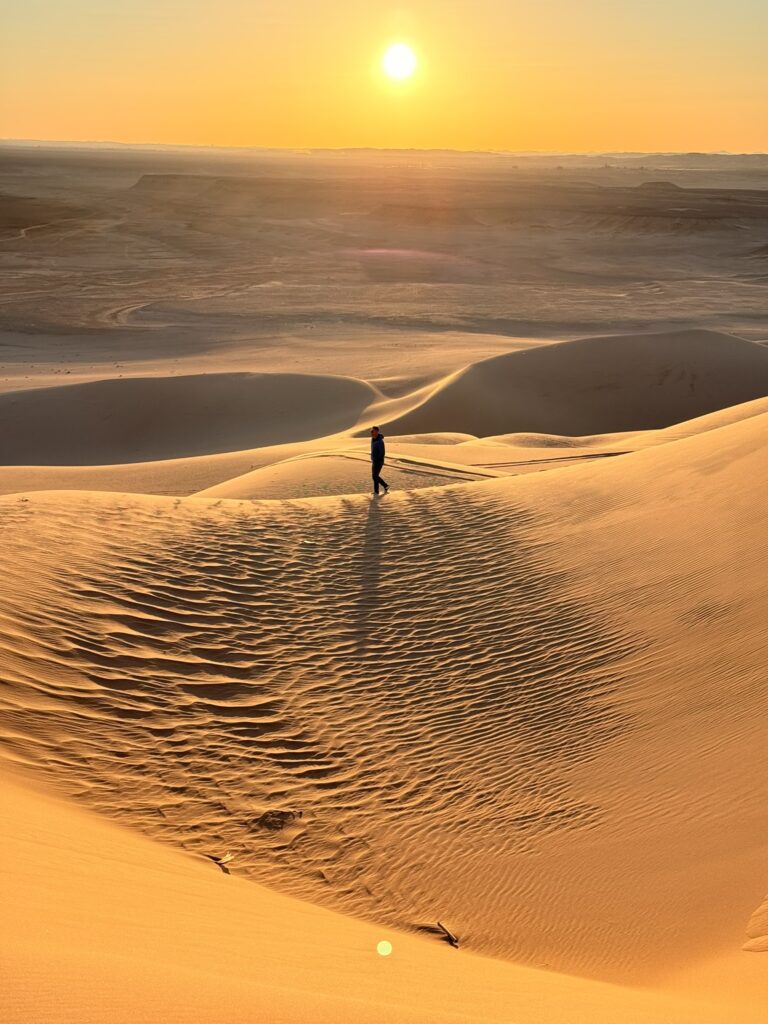
Table of contents
- Traveling to Libya; Visiting Libya in 2025, My Experience (shoot-out and all)
- What’s it like to visit Libya these days?
- How Much Does it Cost to Visit Libya?
- My Libya Tour Itinerary in 2025
- How to Visit Libya in 2025?
- Is Libya Safe to Visit?
- Best Time to Visit Libya?
- How about getting a Libya Visa?
- What about getting to Libya?
- Other things to consider when traveling to Libya
- FINAL THOUGHTS ON VISITING LIBYA?
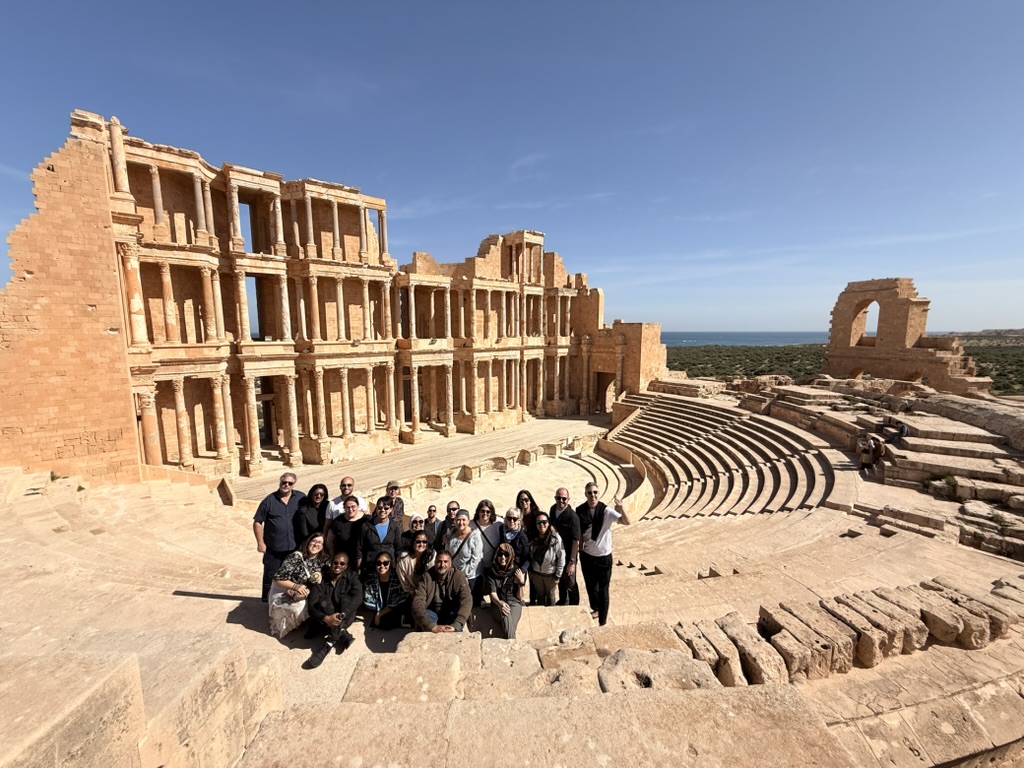
What’s it like to visit Libya these days?
No tourist infrastructure, almost no tourists. But more normal, and much more friendly, than you probably expect. We had people offering gifts, and buying meals, consistently throughout the stay.
The reality is that Libya’s tourism industry hasn’t recovered since the 2011 revolution, meaning crowds are non-existent at sites like Leptis Magna and Sabratha, two of the most stunning Roman ruins in the world. You’ll have the whole places to yourself. A sad privilege indeed.
The Sahara towns of Ghadames and Ghat offer an ancient desert culture. With an authenticity that you just don’t find in Tunisia, Morocco or Egypt. THE REAL SAHARA. These places are infinitely more beautiful than the chinese tour bus versions in neighboring countries, and are completely empty.
Tripoli, the capital, while chaotic, still retains charm with its Ottoman-era old town and Mediterranean coastline. The architecture is gorgeous. And the city is alive (booze is illegal though, a sad fact for the group that I brought with me!).
How Much Does it Cost to Visit Libya?
My 2026 Libya tour will be around $2200 for 6 days. Not cheap, but not crazy expensive to visit one of the most notoriously difficult countries in the world! It’s a lot of paperwork on our end, but it’s all worth it of course.
Once in the country, it’s pretty cheap. On my tour, you’ll probably end up spending about $100 in the 6 days. Crazy.
My Libya Tour Itinerary in 2025
Traveling to Libya with one of my OneStep4Ward group tours had been on my radar for years. Ever since I took a crazy leap of faith to visit Libya back in 2017 with no visa and a promise from a stranger. A land of untouched Roman ruins, ancient desert cities, and a slice of the real Sahara that few travelers ever get to see. With visas notoriously tricky and the country often off-limits, this was an opportunity I couldn’t pass up.
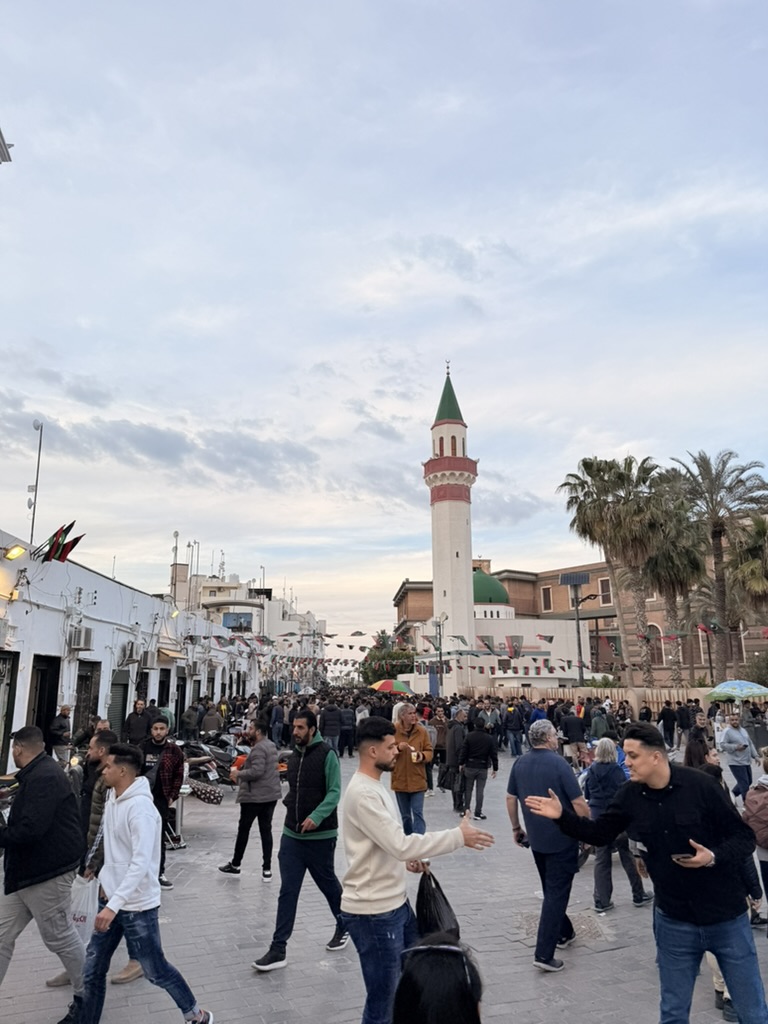
Tripoli
I landed in Tunis the night before the trip, resting up before the real adventure began. And by resting up, I mean half drunk from spending all my airmiles on Qatar business class and being in no state to do anything but sleep!
The next morning, our group flew together from Tunis into Tripoli, stepping into a city where history and modernity collide in the most unexpected ways. Landing in Tripoli felt like an adventure. Little did anyone know, but just 5 days ago, the airline had called me to tell me that none of my group was allowed to board the flight to Tripoli! The airline only had permission to accept Libyans apparently. Queue panic stations for 3 days! Hours on the phone, day in and day out, and after some ‘smoothing’ of operations, we got permission 2 days before we flew.
We made it
Checking in, in Tunis airport, and watching everyone get their boarding passes was a relief to say that least.
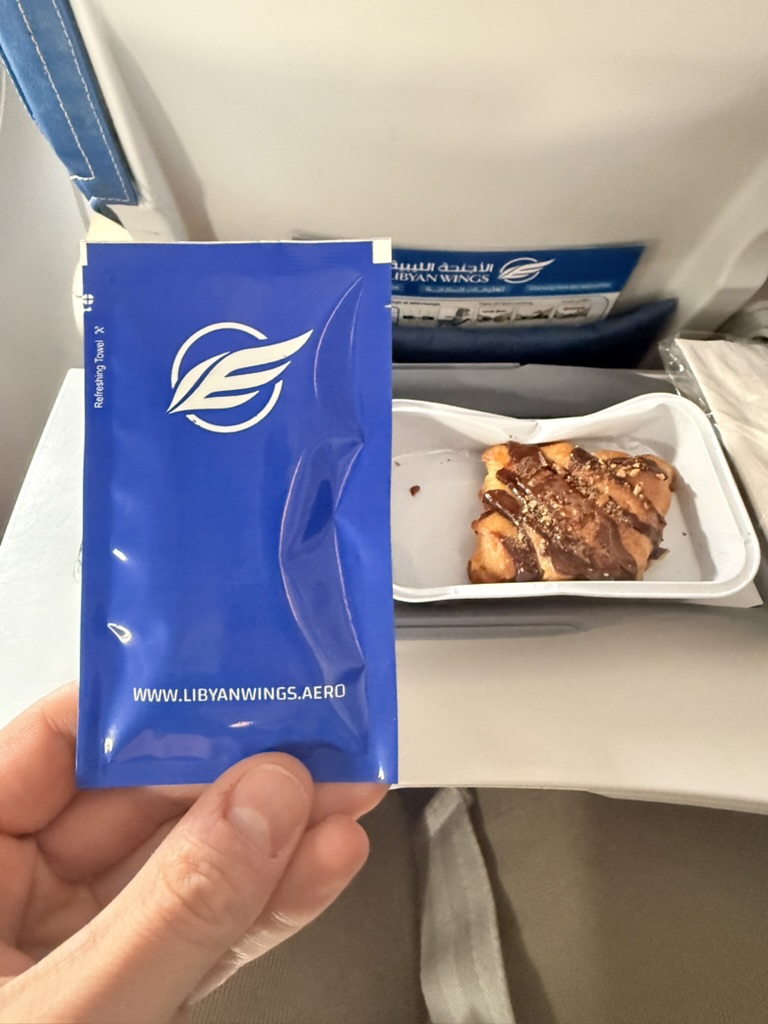
Our guide wasted no time—before we even checked in, we were whisked off on a tour of the capital. Tripoli’s old town, with its labyrinthine alleyways, Ottoman-era buildings, and buzzing souks, was the perfect introduction to Libya.
The Red Castle loomed over Martyrs’ Square, and as the call to prayer echoed through the streets, it felt like stepping into another era. The local markets, around sunset, were buzzing. People were surprised by the modern buildings, scy scrapers, lovely coffee shops. Under Gaddafi this place was awash with oil money. This was all a memory of that. Brought together with a sad modern twist as you see bullet holes to this day across many of the buildings.
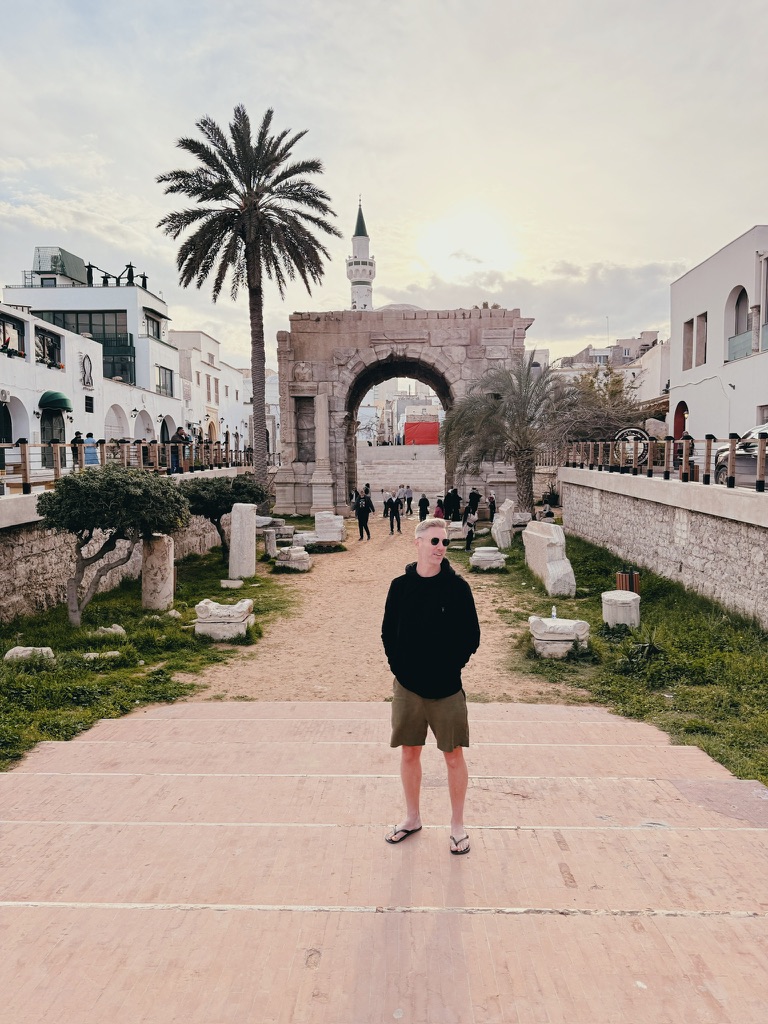
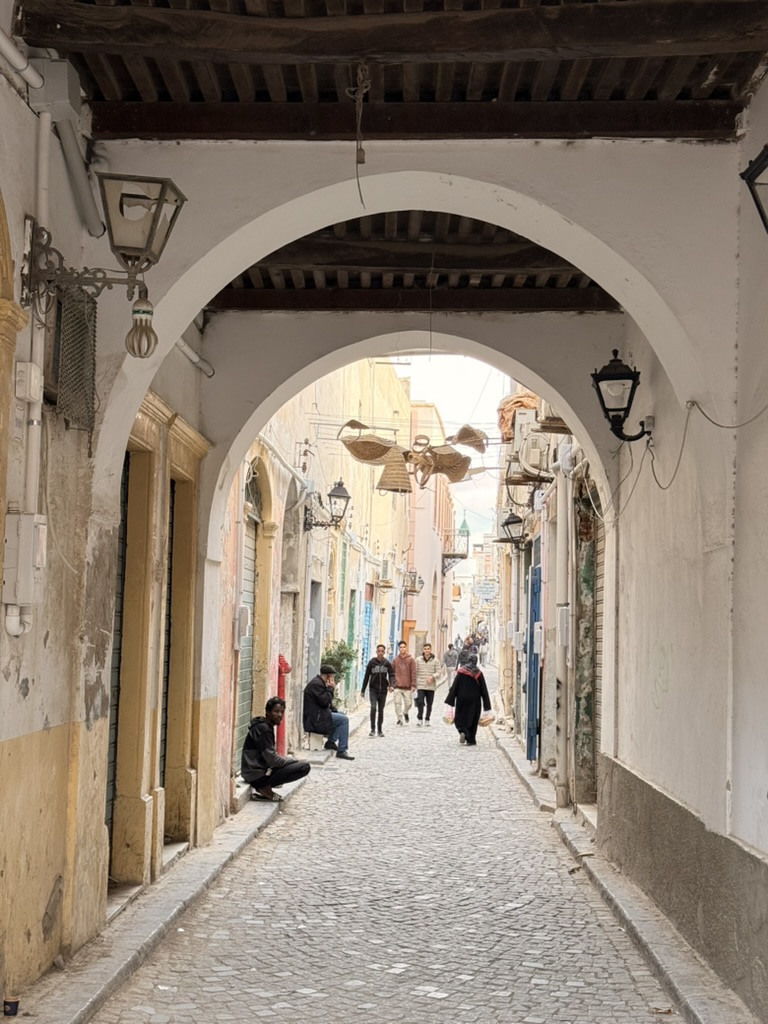
Day 2, we left Tripoli behind, heading deep into Libya’s heartland. Our first stop was Jebel Nafusa, a rugged mountain range home to Berber villages that have stood for centuries. The air was cooler up here, and the landscape, dotted with ancient troglodyte dwellings, felt worlds away from the Mediterranean coast. Real travel. God I love this stuff.
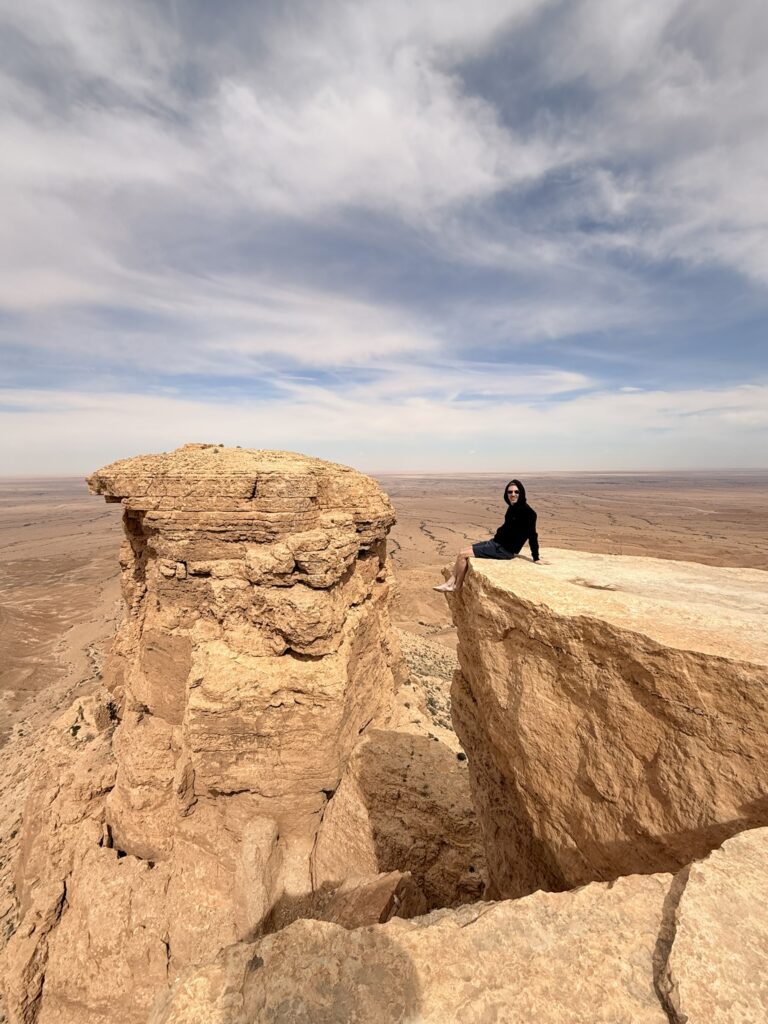
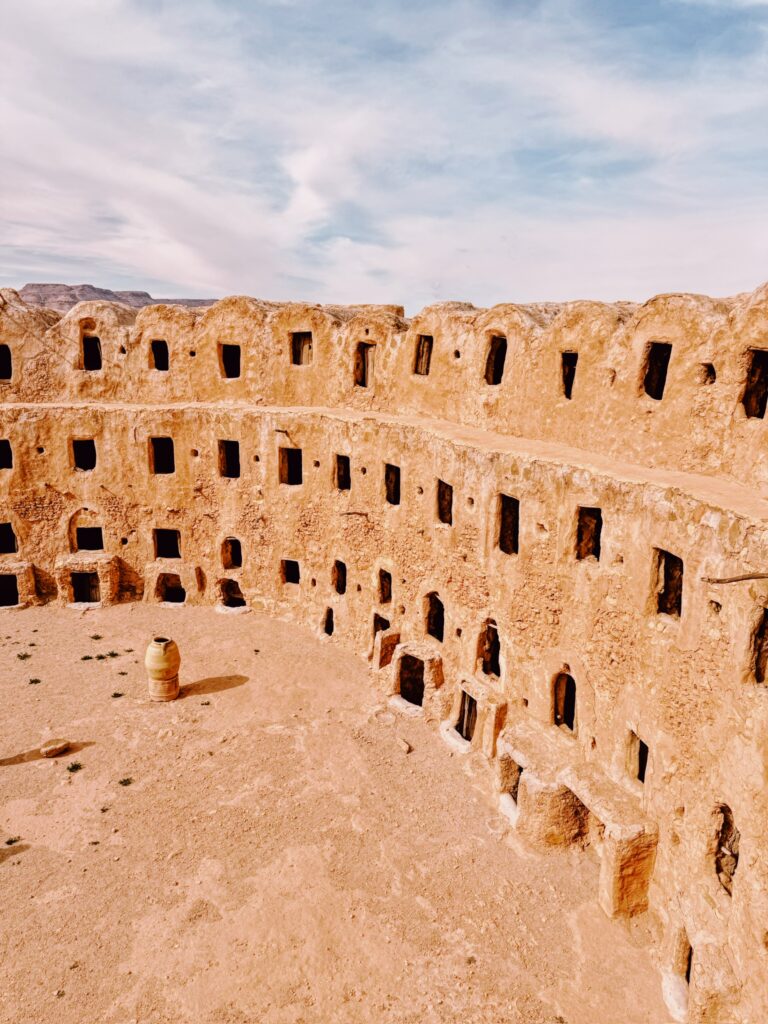
After exploring the region, we hit the road for the long haul—seven hours of desert driving ahead, pushing on toward the legendary oasis town of Ghadames. A UNESCO world heritage site. We arrived, had dinner, and hit the sack.
Ghadames
The next morning, felt like unlocking a hidden level in travel. Known as the “Pearl of the Desert,” this ancient city has been a vital trade hub for millennia, sitting at the crossroads of caravans that once connected the heart of Africa to the Mediterranean.
Lunch in the local houses was a sight.
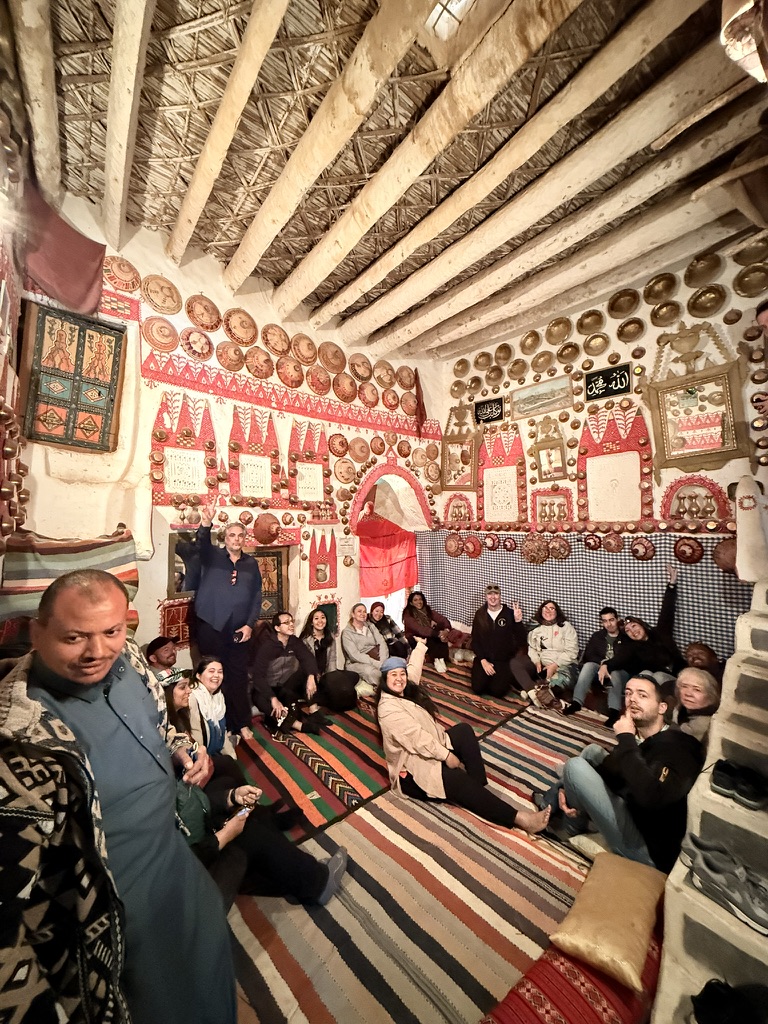
The old town was an architectural marvel—whitewashed passageways twisting and turning under covered alleys, designed to shield the residents from the relentless desert sun.

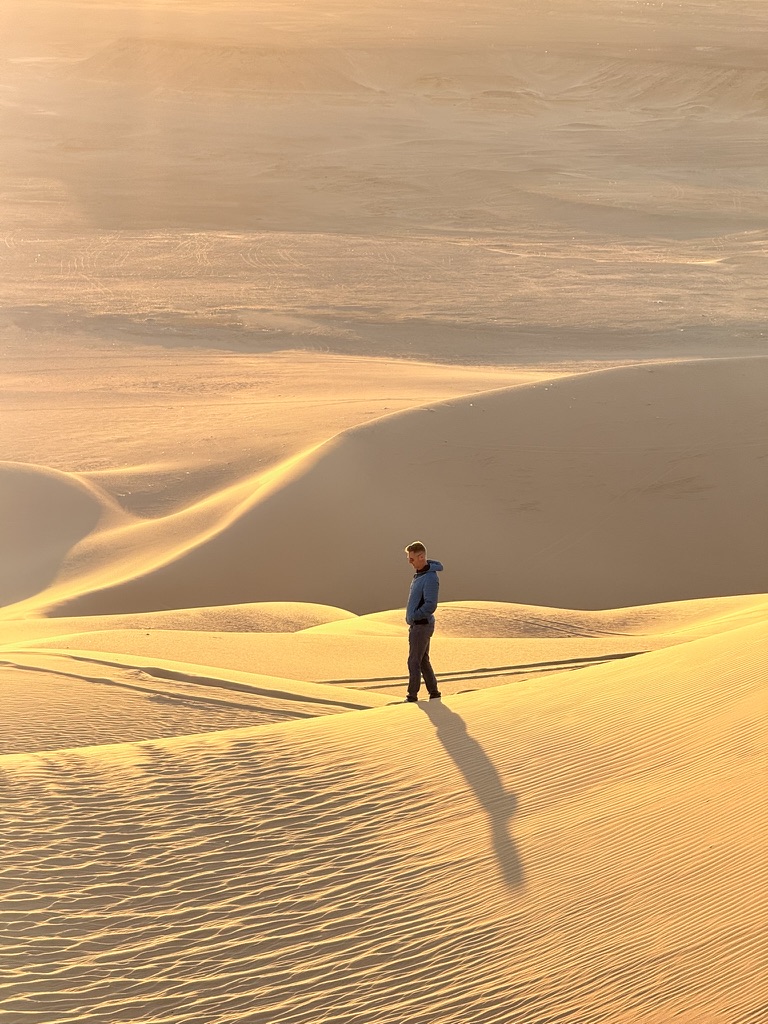
We spent the next two days exploring its secrets, from traditional homes with colorfully painted interiors to the vast sand dunes just outside the city. Sunset over the Sahara, with the sky painted in deep oranges and purples, was a moment I won’t forget.
The Touareg people are here too. I hadn’t seen them since that time we rented a plane and visited Timbuktu in Mali.

Leaving Ghadames, we made our way back to Tripoli, but not without stops in Kabaw and Gharyan. Kabaw’s ancient granary, perched high in the mountains, looked like something out of a Star Wars set, while Gharyan was famous for its underground homes carved directly into the rock. Libya’s diverse landscapes never failed to surprise me.
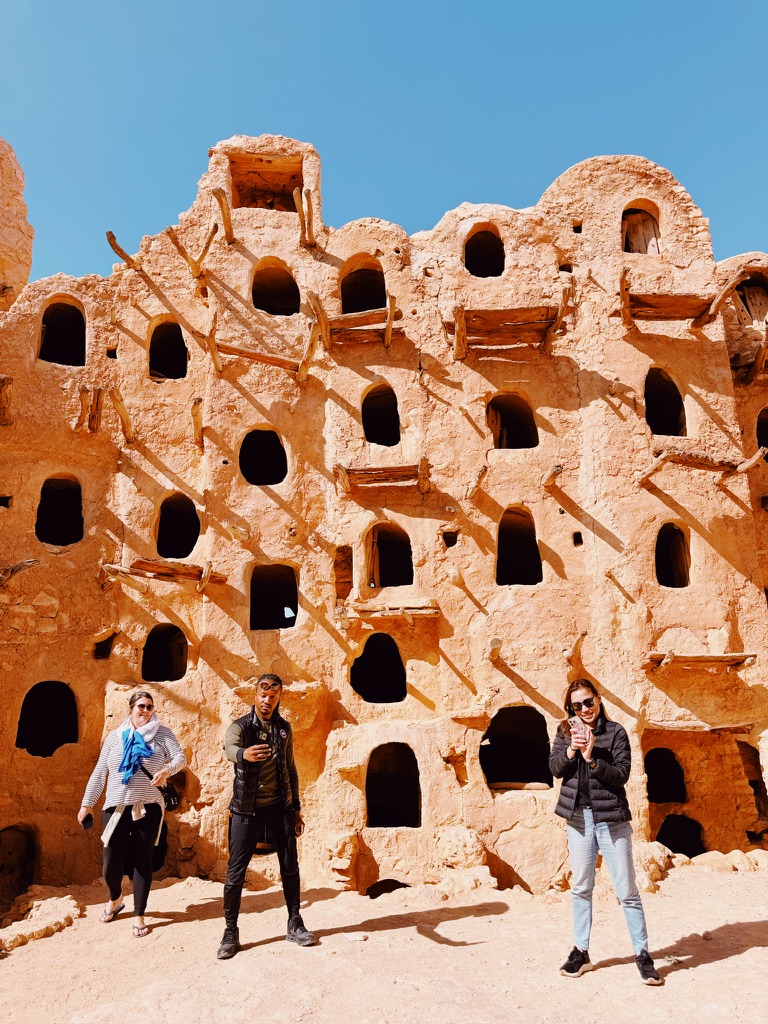
Leptis Magna
The adventure wasn’t over yet—next up was Leptis Magna, possibly the most underrated Roman site in the world.
If this place were in Italy, it’d be packed with tourists, but here, we had it entirely to ourselves. The massive amphitheater, the grand archways, the intricate mosaics—it was a reminder that this land was once a thriving part of the Roman Empire. Walking through its ruins, you could almost hear the echoes of the past.
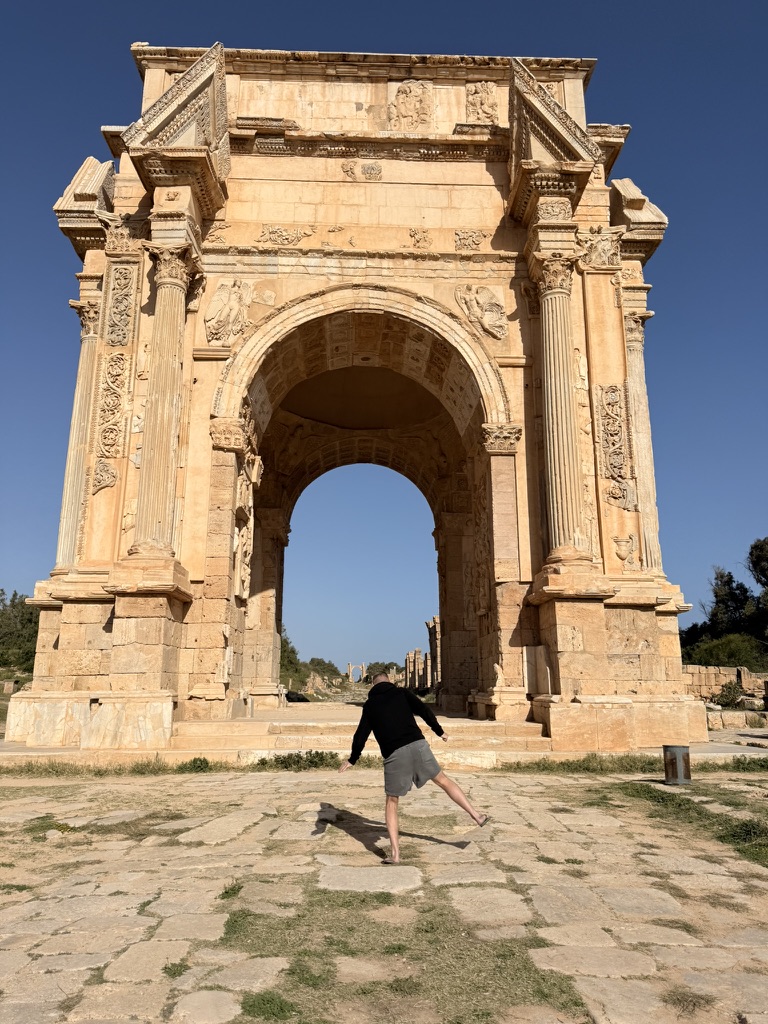
Shoot-out in Tripoli..
One final thing on our last day. Traveling to Libya had gone too smoothly I guess. On the way back from Leptis Magna, we heard some fireworks from our bus. Suddenly the bus pulled to a halt. We were back in Tripoli, but why were we stopped in the middle of the road?.
Pop, pop, pop, pop. I looked down the aisle of the bus and through the front window. Flashes from a guys wrist. WTF. “Get DOWN”. Our security guy screams, as he ducks and made his way to the back of the bus. POP POP POP POP. I was looking down the aisle, and more flashes. One guy holds an AK47 in one hand and sprays. Bang, one guy gets hit and drops to the floor.
AK47 spraying
I couldn’t work out what was happening, but it appeared to be about a 5 on 5. Both groups with AK47s spraying. People around us were leaving their cars and sprinting away from the scene. Some using our bus as shelter from the gunfire. Our driver tried urgently to 3-point-turn, but the road was too narrow. So one last ‘get down’, and rather than wait for things to potentially he escalated, he sped up and drove right by the melee. Head ducked. Directly past the shoot out, with us ducked or lying in the bus. Bloody hell. That was something.
We heard on the news later that the Government had been transporting a high-value prisoner, and the rebels had tried to intervene. And a shoot out ensued. Just as we were driving past. Awful timing.
The group handled it pretty well. I guess this is what we signed up for. We headed back downtown and went for coffee in the old city. Nerves jangled and adrenline pumping. Quite a day to finish our libya travels.
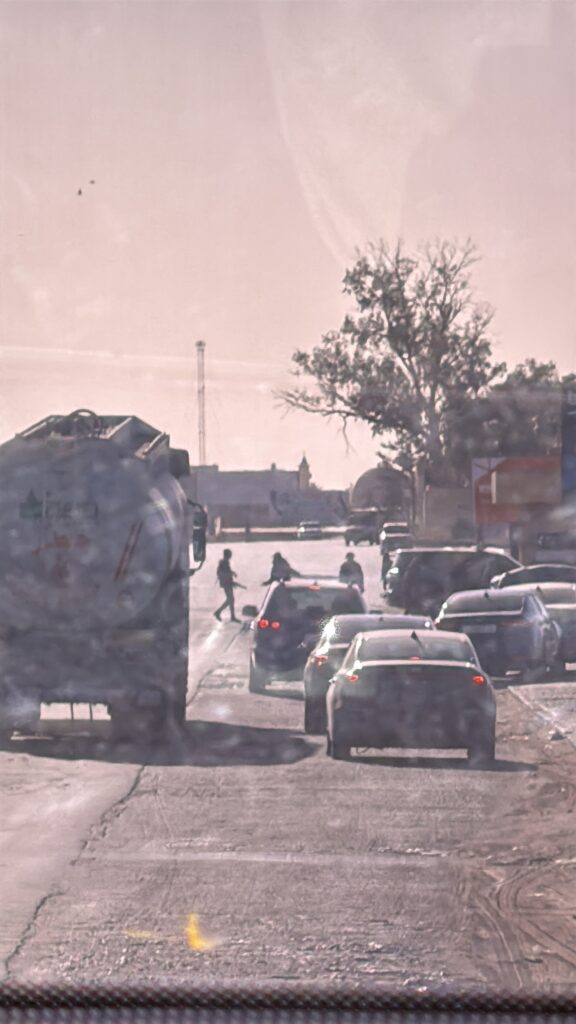
Sabratha (and a shoot out)
For the final stretch, we headed to Sabratha, another incredible Roman city perched right on the Mediterranean. The ruins here were equally impressive, and the backdrop of crashing waves made it even more surreal. It was the perfect way to close out an unforgettable journey. Straight to the airport from here.
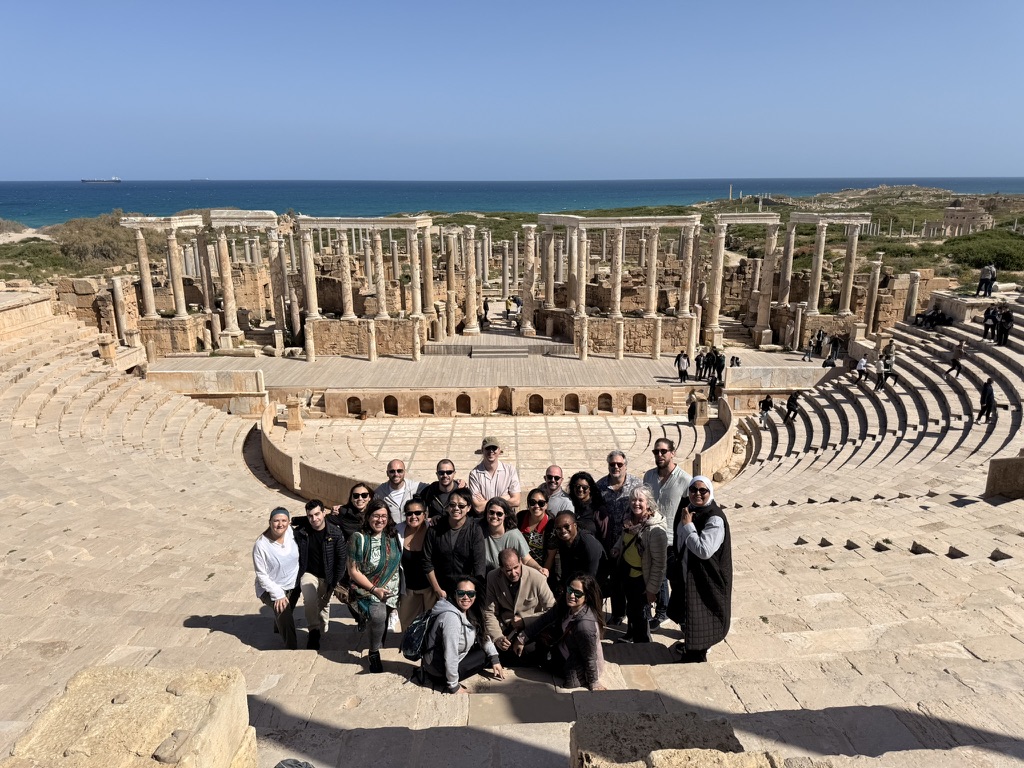
Next stop? Syria
From the chaotic streets of Tripoli to the vast silence of the Sahara, this trip was everything I love about travel—raw, real, and completely off the beaten path.
And just like that, I was off again, catching my flight to Amman, Jordan ready for the next adventure: Syria.
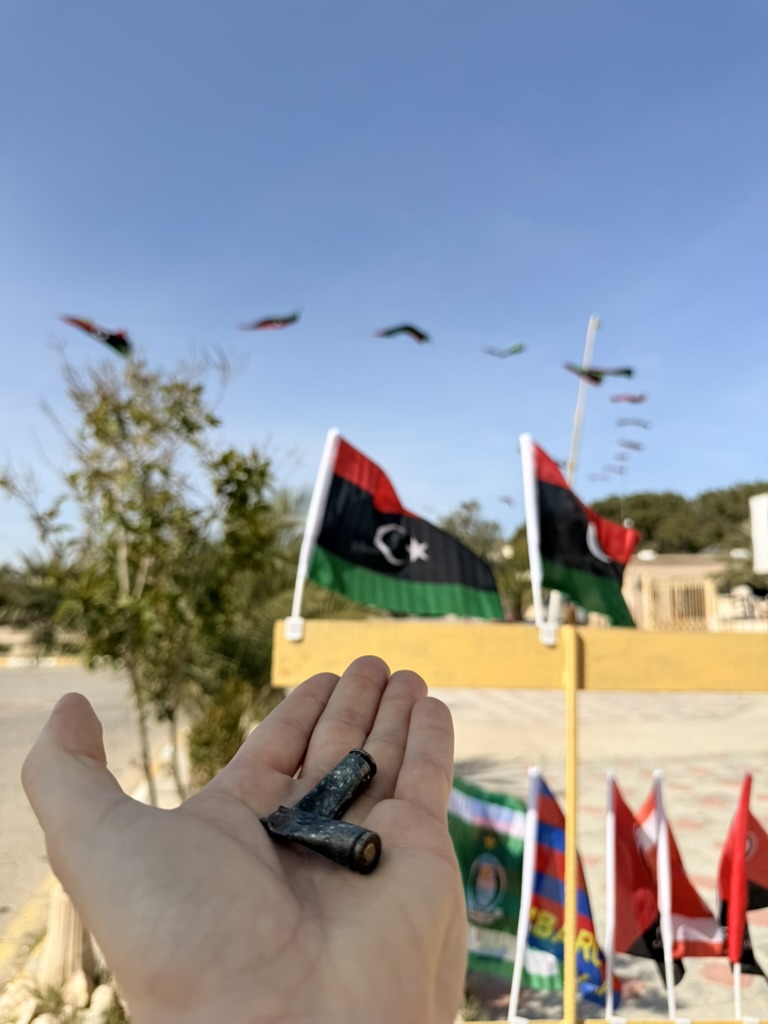
How to Visit Libya in 2025?
Visiting Libya in 2025 is possible but requires careful planning due to visa restrictions and security concerns. Here’s what you need to know:
• Visa & Entry Requirements: Traveling to Libya does not issue tourist visas on arrival. You must arrange a visa through a Libyan tour operator, which will sponsor your visit and provide an invitation letter. This is typically required to obtain a visa from a Libyan embassy.
• Flights: The safest route is flying via Tunisia. Many travelers first land in Tunis and then take a direct flight to Tripoli. Some flights are also available from Istanbul.
• Tours & Guides: Independent travel is not recommended. You must book with a registered Libyan tour company, as they will handle permits, security arrangements, and local logistics.
• Currency: The Libyan Dinar (LYD) is a closed currency, meaning you must exchange money inside the country. Credit cards are not widely accepted.
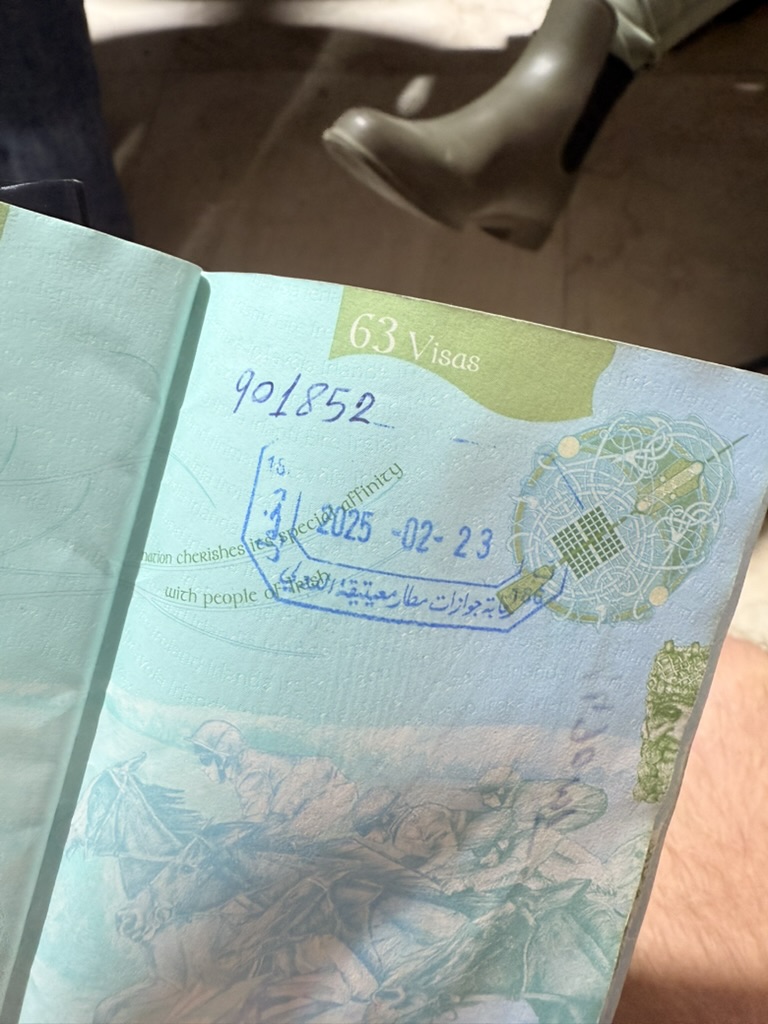
Is Libya Safe to Visit?
Kinda of. And generally yes. But it’s not Thailand, or Spain. That’s for sure. We witnessed a shootout on our last day, so I can’t say it’s ‘safe’. Apart from that though it was fine…
The reality is Traveling to Libya remains a challenging destination due to ongoing political instability and security risks. However, certain areas, particularly in the northwest, are relatively stable and can be visited with the right precautions.
• Safe Areas: Tripoli, Leptis Magna, Sabratha, and Ghadames are among the most accessible places for travelers. These areas are under the control of Libya’s Government of National Unity (GNU), where tours operate.
• Restricted Zones: The south and eastern regions, including Benghazi, remain unpredictable and are generally not open to foreign tourists.
• Security Measures: Your tour company will provide security updates and ensure safe travel routes. Always follow their advice and avoid discussing political matters with locals.
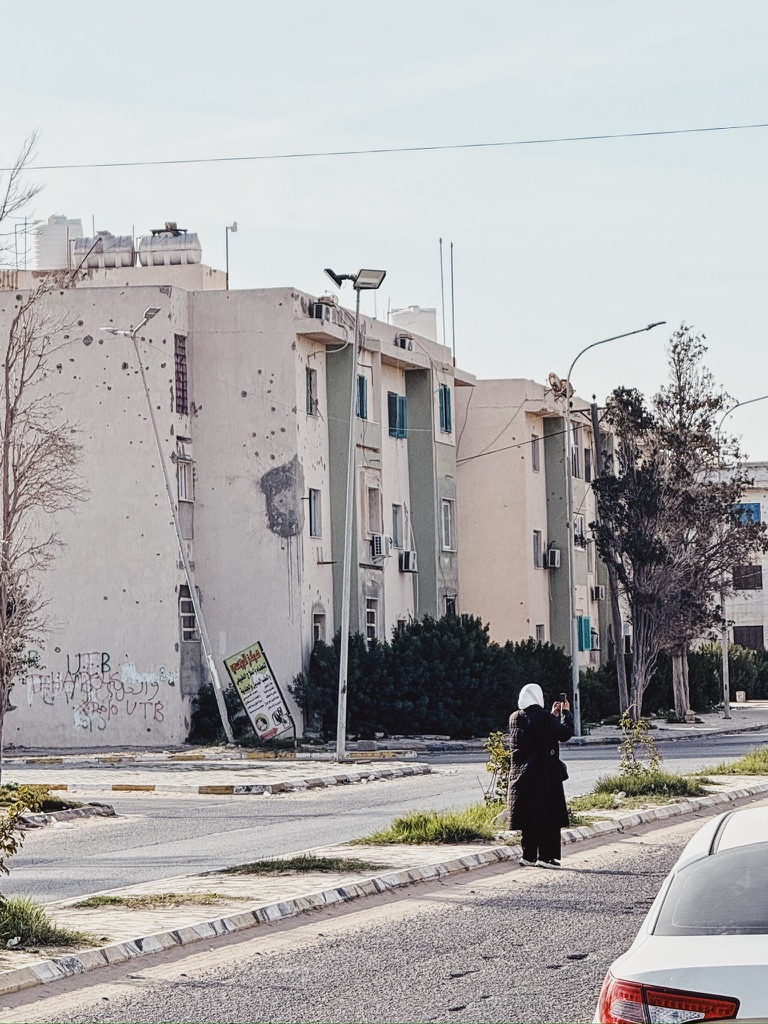
Best Time to Visit Libya?
The best time to visit Libya is during the cooler months:
• October to April: Ideal for exploring Roman ruins, desert landscapes, and cities without extreme heat.
• Summer (May to September): Best avoided, especially for desert trips, as temperatures can soar above 40°C (104°F).
For 2025, if Libya remains accessible for tourism, aim for a trip in March–April or October–November for the best weather and travel conditions.
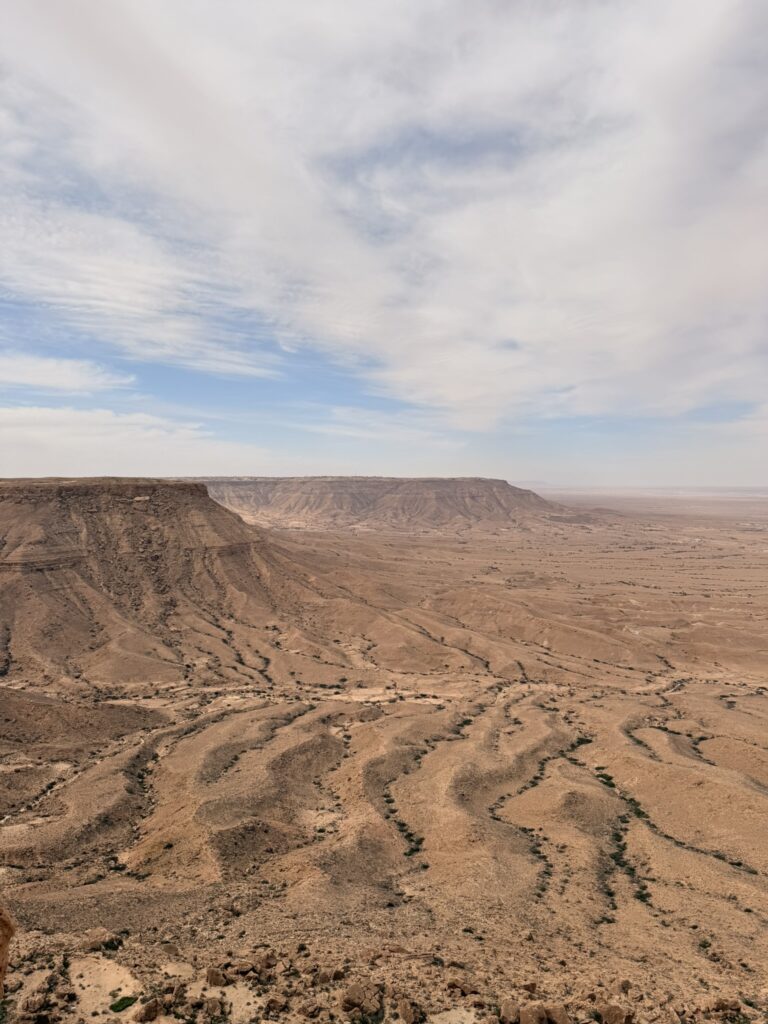
How about getting a Libya Visa?
Much easier than before. Still not easy.
Libya now offers an eVisa system, making it easier than ever to visit. However, the process still requires some planning. Here’s how you can obtain a visa for Libya in 2025:
- Get an Invitation Letter
While the eVisa is more accessible, many travelers still require a sponsorship letter from a registered Libyan tour company, especially for tourism. Your tour operator will arrange this as part of your trip.
2. Apply for a Libya eVisa
Libya introduced its eVisa system, allowing travelers to apply online. You will need:
- A passport valid for at least six months
- A digital passport photo
- Proof of accommodation or an invitation letter from a Libyan tour operator
- A return flight ticket
Processing times vary but usually take 2–4 weeks, so apply early.

What about getting to Libya?
Actually sorting logistics in traveling to Libya can be tricky. Sanctions mean that you can’t purchase flights from a Libyan carrier. And, to my surprise, they’re only allowed to accept Libyan guests. I had my group book 22 seats on a Libyan carrier, only to then have to.. ahem, cough, cough, ‘organise’ special permission for us to be allowed to board.
For the smoothest journey, the best option is:
Since Libya has no direct flights from Europe or North America, you’ll need to transit through a neighboring country, normally Tunisia, Turkiye, Egypt or Jordan.
Best Routes to Tripoli (Mitiga Airport – MJI)
- From Tunisia: The most common entry point. Flights operate from Tunis-Carthage Airport (TUN) to Tripoli (MJI). Many travelers spend a night in Tunis before flying to Libya. That’s what we did.
- From Turkey: Turkish Airlines and Libyan carriers operate flights from Istanbul to Tripoli.
- From Egypt: Some flights from Cairo, but these are not always reliable.
- From Jordan: Flights from Amman, a solid bet.
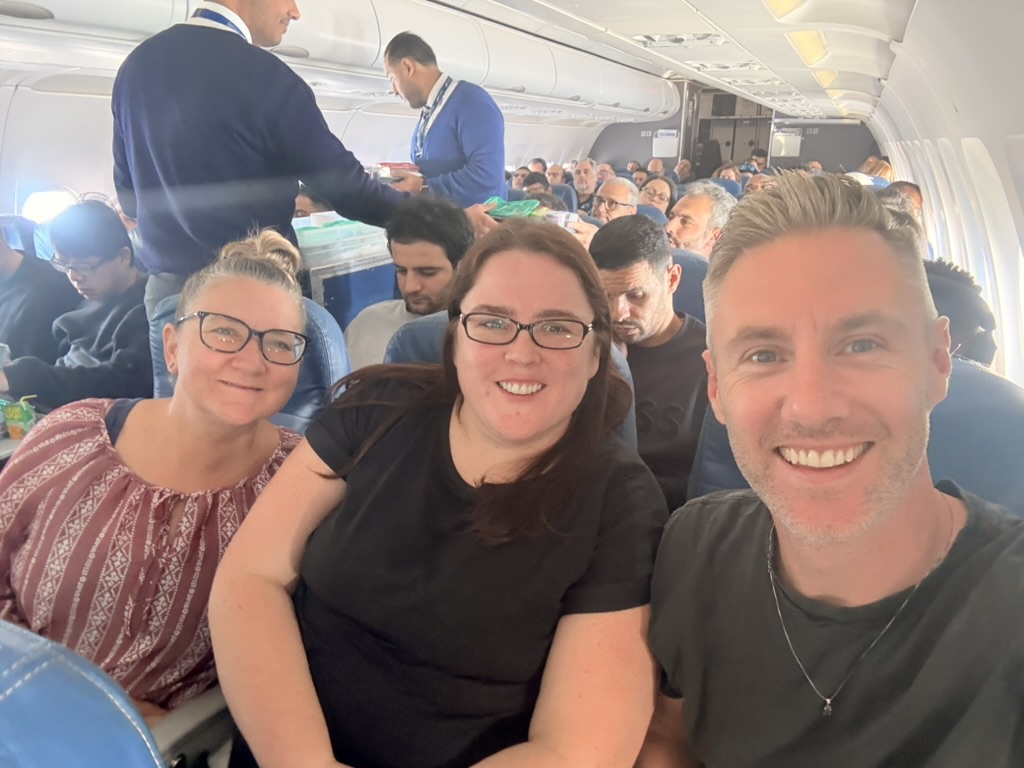
Other things to consider when traveling to Libya
Money
No cards or ATMs work. So it’s cash only. Bring a stash of USD.
Safety
Just be smart. Of course, you must join a group. But then keep your head down. The people are super friendly (especially to Irish!), but they’re not in love with American’s or Brits. That being said, everyone is delighted to see tourists once more.
In the main areas, things are normally calm. The shoot-out we witnessed was apparently rare, and of course we weren’t the targets. And aside from that (haha!) everything was super calm.
Admin
Quite a lot! On my tour, I manage everything I can. But the flights are tricky, the visa is tricky, the permits to access other places within Libya are tricky, and having an armed guard with us throughout is a strange experience if you’ve never been to Somalia, Mauritania, or Central African Republic etc.
Internet in Libya
Surprisingly ok. The hotel wifi was 6/10, and you can get a simcard for $10 or so. Unrestricted 4 and 5G. Surprising!
Food in Libya
Great! Modern restaurants, full arabic fare (and pizza/pasta options). Coffees, juices. It was great. Like being in Dubai or Beirut (well not quite, but you get the picture)
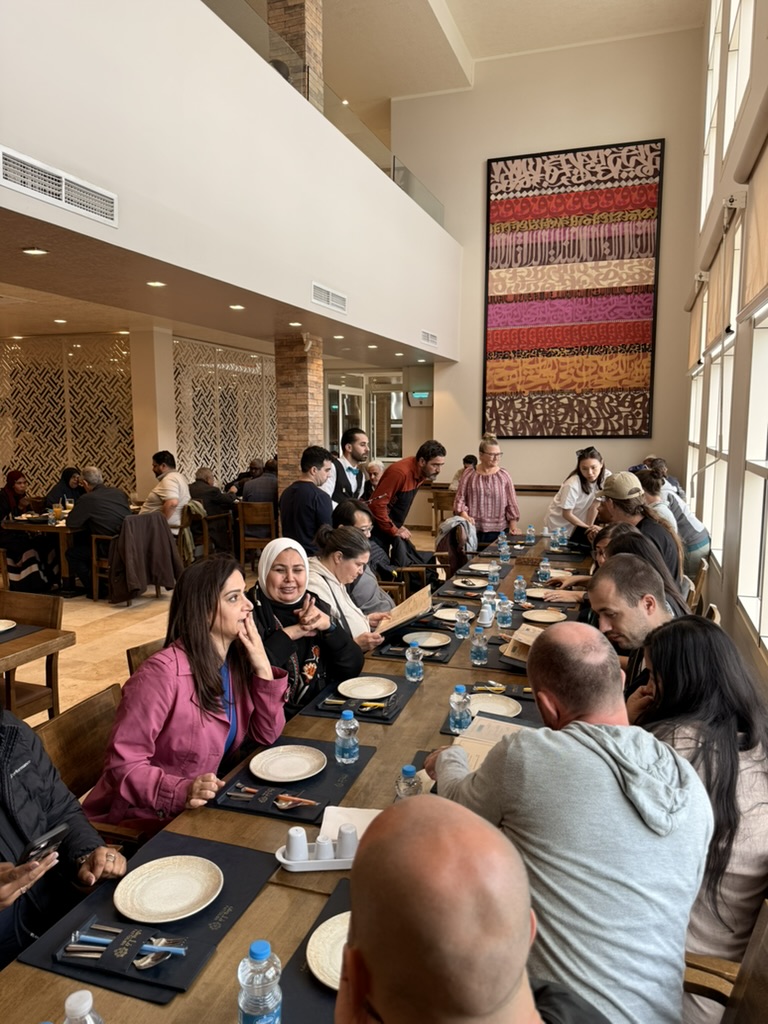
Accommodation in Libya
Above my expectations. The hotels are a little dated due to no money in the tourist industry, but the hotels themselves are expansive and nice. Hot water, wifi, proper beds, sheets and pillows (I know this may sound obvious, but if you travel to weird places, this can never be taken as a given!)
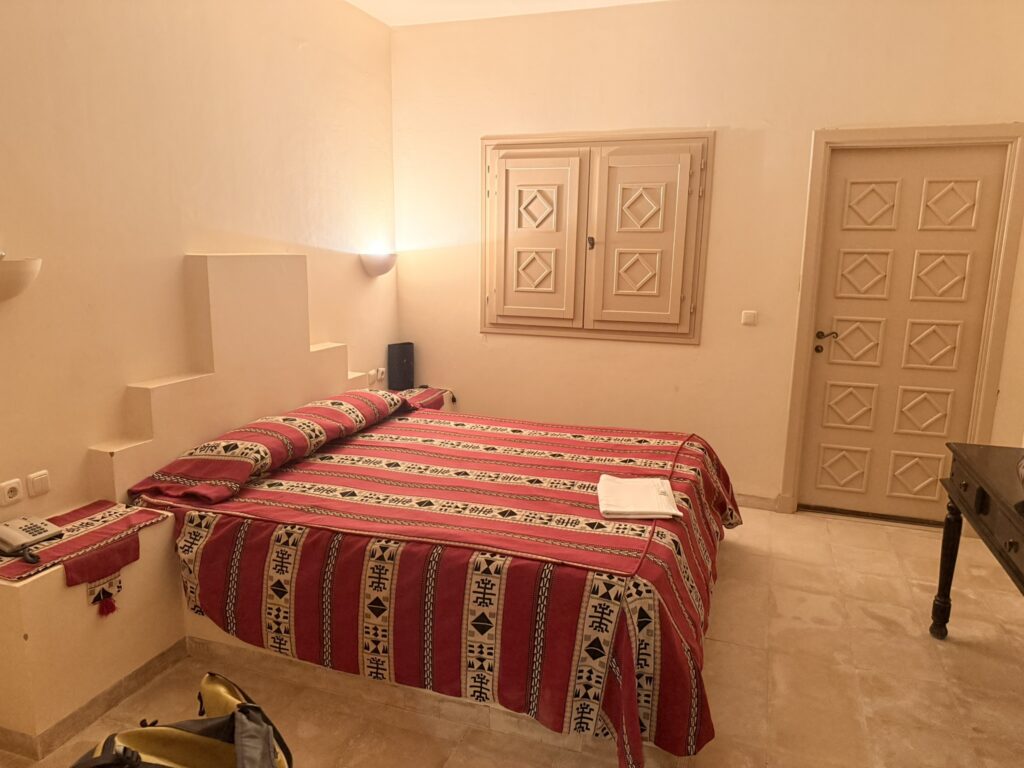
The people
To be honest, in Traveling to Libya, the people were a real highlight. People were screaming ‘welcome to Libya’ from across streets and highways. Endless waves, and smiles. And as I mentioned above, it was difficult to pay for stuff. Everyone wanted to give gifts and say thank you for us being there. Really beautiful. The markets of Cairo and Marrakech, it is not!
FINAL THOUGHTS ON VISITING LIBYA?
Life is short. The world is beautiful. Just do it. See for yourself all these places you hear about in the news. And even better, come do it with me, it’s much more fun that way. Join my 2026 Libya Tour. See you in Tripoli next year!
Remember, never travel without travel insurance! And never overpay for travel insurance!
I use HeyMondo. You get INSTANT quotes. Super cheap, they actually pay out, AND they cover almost everywhere, where most insurance companies don't (even places like Central African Republic etc!). You can sign-up here. PS You even get 5% off if you use MY LINK! You can even sign up if you're already overseas and traveling, pretty cool.
Also, if you want to start a blog...I CAN HELP YOU!
Also, if you want to start a blog, and start to change your life, I'd love to help you! Email me on johnny@onestep4ward.com. In the meantime, check out my super easy blog post on how to start a travel blog in under 30 minutes, here! And if you just want to get cracking, use BlueHost at a discount, through me.
Also, (if you're like me, and awful with tech-stuff) email me and my team can get a blog up and running for you, designed and everything, for $699 - email johnny@onestep4ward.com to get started.
Do you work remotely? Are you a digital nomad/blogger etc? You need to be insured too.
I use SafetyWing for my digital nomad insurance. It covers me while I live overseas. It's just $10 a week, and it's amazing! No upfront fees, you just pay week by week, and you can sign up just for a week if you want, then switch it off and on whenever. You can read my review here, and you can sign-up here!





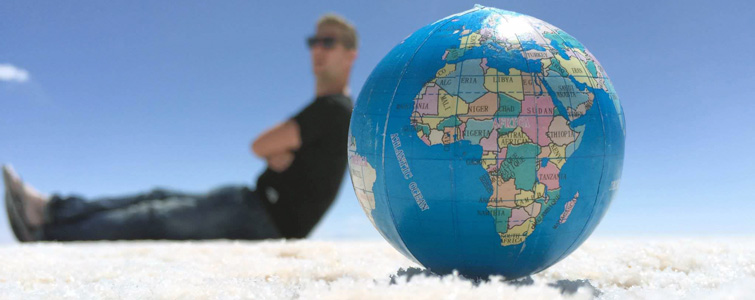






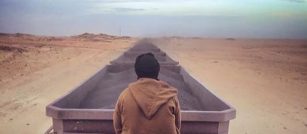
 As you know, blogging changed my life. I left Ireland broke, with no plan, with just a one-way ticket to Thailand
and no money. Since then, I started a blog, then a digital media company, I've made
more than $1,500,000 USD, bought 4 properties and visited (almost) every country in the world. And I did it all from my laptop as I
travel the world and live my dream. I talk about how I did it, and how you can do it too, in my COMPLETELY FREE
Ebook, all 20,000
words or so. Just finish the process by putting in your email below and I'll mail it right out to you immediately. No spam ever too, I promise!
As you know, blogging changed my life. I left Ireland broke, with no plan, with just a one-way ticket to Thailand
and no money. Since then, I started a blog, then a digital media company, I've made
more than $1,500,000 USD, bought 4 properties and visited (almost) every country in the world. And I did it all from my laptop as I
travel the world and live my dream. I talk about how I did it, and how you can do it too, in my COMPLETELY FREE
Ebook, all 20,000
words or so. Just finish the process by putting in your email below and I'll mail it right out to you immediately. No spam ever too, I promise!
